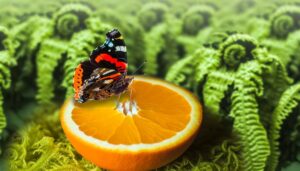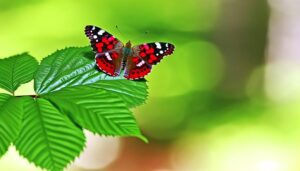On Which Plants Do Red Admiral Butterflies Lay Their Eggs?
Red Admiral butterflies mainly lay their eggs on the serrated, ovate leaves of stinging nettle plants (Urtica dioica). These plants provide essential nutrients via high nitrogen concentration, supporting rapid larval growth and increased survival rates.
The nettles' rough texture and spines enhance egg adhesion and protection from predators. Favorable egg-laying environments include sunlit, sheltered locations with ideal temperatures and high humidity to prevent desiccation.
Eggs are typically placed singly on the upper leaves to minimize competition and predation risks. Understanding these specific site selection strategies provides insights into their intricate reproductive behavior.

Key Takeaways
- Red Admiral butterflies lay their eggs primarily on stinging nettles (Urtica dioica).
- Eggs are usually placed on the undersides of nettle leaves for protection.
- Optimal sites have high humidity to prevent egg desiccation.
- Females prefer sunlit yet sheltered areas with abundant host plants.
Preferred Host Plants

Red Admiral butterflies (Vanessa atalanta) exhibit a strong preference for depositing their eggs on stinging nettle (Urtica dioica), leveraging the plant's widespread availability and nutritional suitability for their larvae.
Research indicates that Urtica dioica provides essential nutrients required for the ideal growth and development of Red Admiral caterpillars. The plant's high concentration of nitrogen compounds is particularly beneficial, supporting rapid larval development and increasing survival rates.
Additionally, stinging nettles offer a defensive advantage, as their spines deter many potential predators. Studies show that larvae reared on Urtica dioica exhibit higher fitness levels compared to those on alternative host plants.
This evolutionary adaptation underscores the intricate ecological relationship between Vanessa atalanta and Urtica dioica, ensuring successful propagation of the species.
Habitat Preferences
Vanessa atalanta thrives in diverse habitats, ranging from woodlands and meadows to urban parks and gardens, where suitable host plants and environmental conditions are readily available.
These butterflies exhibit a preference for environments that offer:
- Abundance of Host Plants: Nettles (Urtica spp.) are vital for egg-laying, providing essential nourishment for larvae.
- Sunlit Areas: Warm, sunlit patches are favored, aiding in thermoregulation and enhancing growth rates.
- Sheltered Locations: Protection from wind and predators is essential, often found in hedgerows and underbrush.
- Proximity to Nectar Sources: Adult butterflies depend on nectar from flowers like buddleia and thistles for sustenance.
These preferences guarantee ideal conditions for the survival and development of their offspring, reflecting an intricate balance between ecological needs and environmental availability.
Egg-Laying Seasons

Red Admiral butterflies exhibit peak breeding periods primarily in late spring and early summer, with notable seasonal variations influenced by geographical location.
Studies indicate that climate fluctuations, particularly temperature and precipitation patterns, greatly impact the timing and frequency of egg-laying.
Understanding these dynamics is essential for predicting population trends and implementing conservation strategies.
Peak Breeding Periods
The peak breeding periods for Red Admiral butterflies, typically occurring in late spring and early summer, coincide with favorable environmental conditions that support the growth of their preferred host plants.
These ideal conditions are vital for the survival of their larvae. The primary host plant, stinging nettle (Urtica dioica), thrives during this time, providing an abundant food source.
Research indicates that these periods are marked by:
- Mild temperatures – Favorable for larval development.
- Increased daylight hours – Enhancing plant growth and larval feeding opportunities.
- Higher humidity levels – Reducing desiccation risks for eggs and larvae.
- Reduced predation – Due to synchronized population dynamics.
Understanding these factors is essential for conservation efforts and habitat management aimed at supporting Red Admiral populations.
Seasonal Variations Observed
Seasonal variations in egg-laying patterns of the Red Admiral butterflies reflect the adaptability of these insects to fluctuating environmental conditions. These butterflies exhibit distinct seasonal shifts in their reproductive behaviors, primarily influenced by temperature, day-length, and availability of host plants.
| Season | Egg-Laying Patterns |
|---|---|
| Spring | Increased activity due to rising temperatures and abundant foliage. |
| Summer | Peak egg-laying period; ideal temperatures and plentiful food sources. |
| Autumn | Decreased activity as temperatures drop and daylight shortens. |
During spring, the emergence of fresh vegetation provides ample sites for oviposition. In summer, favorable climatic conditions enable the highest reproductive output. Conversely, the onset of autumn sees a marked decline in egg-laying as environmental conditions become less conducive.
Climate Impact Analysis
Climate change exerts significant influence on the egg-laying seasons of Red Admiral butterflies, altering traditional patterns and potentially affecting their survival and reproductive success. Shifts in temperature and precipitation disrupt the lifecycle of these insects, leading to:
- Earlier or delayed egg-laying periods: Unseasonal warmth or cold can confuse timing.
- Habitat fragmentation: Changes in climate can lead to loss of suitable egg-laying sites.
- Altered plant phenology: Host plants may bloom earlier or later, impacting larval food sources.
- Increased predation and disease: Climate change can enhance conditions for predators and pathogens.
These factors collectively create a precarious environment, threatening the delicate balance necessary for the species' continuity.
Understanding these dynamics is essential for developing conservation strategies.
Specific Site Selection
Specific site selection for egg-laying by Red Admiral butterflies is critically influenced by the presence of preferred host plants such as nettles. These host plants for Red Admirals provide essential nourishment for the developing larvae, ensuring successful growth and survival. Female butterflies carefully assess the quality and location of potential host plants before depositing their eggs. Factors such as sunlight exposure and plant health play a crucial role in their selection process.
Females meticulously choose leaf surfaces that offer ideal conditions for larval development, often prioritizing the underside of leaves to provide protection from predators and environmental stressors.
Additionally, environmental factors such as temperature, humidity, and sunlight exposure play a significant role in determining the suitability of a site for egg deposition.
Preferred Host Plants
Red Admiral butterflies exhibit a strong preference for laying their eggs on host plants within the Urticaceae family, particularly selecting sites on stinging nettles (Urtica dioica) due to their ideal nutrient composition and favorable microhabitats.
This specific site selection is driven by several key factors:
- Nutrient Availability: Stinging nettles provide essential nutrients critical for larval development.
- Microclimate Suitability: The dense foliage offers a microclimate that protects eggs from extreme weather.
- Reduced Predation: Nettles' stinging hairs deter many potential predators, increasing egg survival rates.
- Optimal Leaf Structure: The plant's morphology supports secure egg attachment and subsequent larval feeding.
This highly selective behavior underscores the intricate relationship between Red Admirals and their preferred host plants, ensuring successful reproduction and species sustainability.
Leaf Surface Choice
In addition to selecting the ideal host plants, Red Admiral butterflies exhibit meticulous behavior in choosing specific leaf surfaces for egg deposition to optimize larval survival.
Research indicates a preference for the undersides of leaves, which provide protection from predators and environmental stressors. The smoothness and micro-topography of the leaf surface are critical factors, as eggs laid on rough or irregular surfaces may be more vulnerable to dislodgement.
Furthermore, females tend to select leaves positioned in shaded or semi-shaded areas, which offer stable microclimates conducive to egg and larval development.
The choice of leaf surface consequently plays a pivotal role in ensuring the successful progression from egg to larva, highlighting the intricate ecological strategies employed by Red Admiral butterflies.
Environmental Factors Influence
Frequently, environmental factors such as temperature, humidity, and light exposure significantly influence the Red Admiral butterflies' precise site selection for egg deposition. These factors guarantee ideal conditions for larval development and survival.
Research indicates that:
- Temperature: Eggs are often laid in areas where temperatures support rapid embryonic development.
- Humidity: High humidity levels prevent desiccation, guaranteeing the eggs remain viable.
- Light Exposure: Adequate light exposure enhances the growth of host plants, providing ample food resources.
- Predator Presence: Sites with fewer predators increase the likelihood of egg survival and subsequent larval success.
These environmental considerations highlight the butterflies' intricate decision-making process, underscoring the importance of suitable habitats for their reproductive success.
Understanding these factors is vital for conservation strategies.
Plant Characteristics

Host plants for Red Admiral butterflies, primarily stinging nettles (Urtica dioica), exhibit specific morphological traits that are essential for the successful attachment and development of their eggs.
These plants possess serrated, ovate leaves with a rough surface texture, providing a superior substrate for egg adhesion. The robust, erect stems guarantee stability, reducing the risk of egg displacement.
High concentrations of essential nutrients within the leaves support larval growth post-hatching. Additionally, stinging nettles excrete chemical compounds that deter herbivores, thereby offering a relatively protected environment for the eggs.
The plant's widespread distribution and perennial life cycle further guarantee availability throughout the breeding season, making it a reliable and consistent host for Red Admiral butterflies.
Survival Strategies
Red Admiral butterflies employ a variety of sophisticated survival strategies to guarantee the successful development and emergence of their offspring.
These strategies are meticulously designed to provide ideal conditions for egg-laying, larval growth, and eventual metamorphosis.
- Host Plant Selection: Female Red Admirals choose nettles (Urtica spp.) due to their nutrient-rich foliage, essential for larval development.
- Egg Placement: Eggs are laid singly on the upper leaves, reducing competition and predation risks.
- Camouflage: The greenish eggs blend seamlessly with the foliage, minimizing visibility to predators.
- Temporal Synchronization: Egg-laying is timed with peak host plant availability, ensuring food abundance for larvae.
These strategies underscore the Red Admiral's evolutionary adaptations, enhancing offspring survival in a competitive ecosystem.
Conclusion
In summation, the red admiral butterfly's oviposition behavior is intricately linked to the availability of preferred host plants, such as nettles, within specific habitats.
Egg-laying seasons align with ecological conditions conducive to larval survival, while site selection is dictated by plant characteristics and microhabitat conditions.
These survival strategies are emblematic of a finely-tuned evolutionary process, ensuring progeny thrive amidst environmental vicissitudes.
This synthesis underscores the butterfly's adaptive prowess within its ecological niche.






